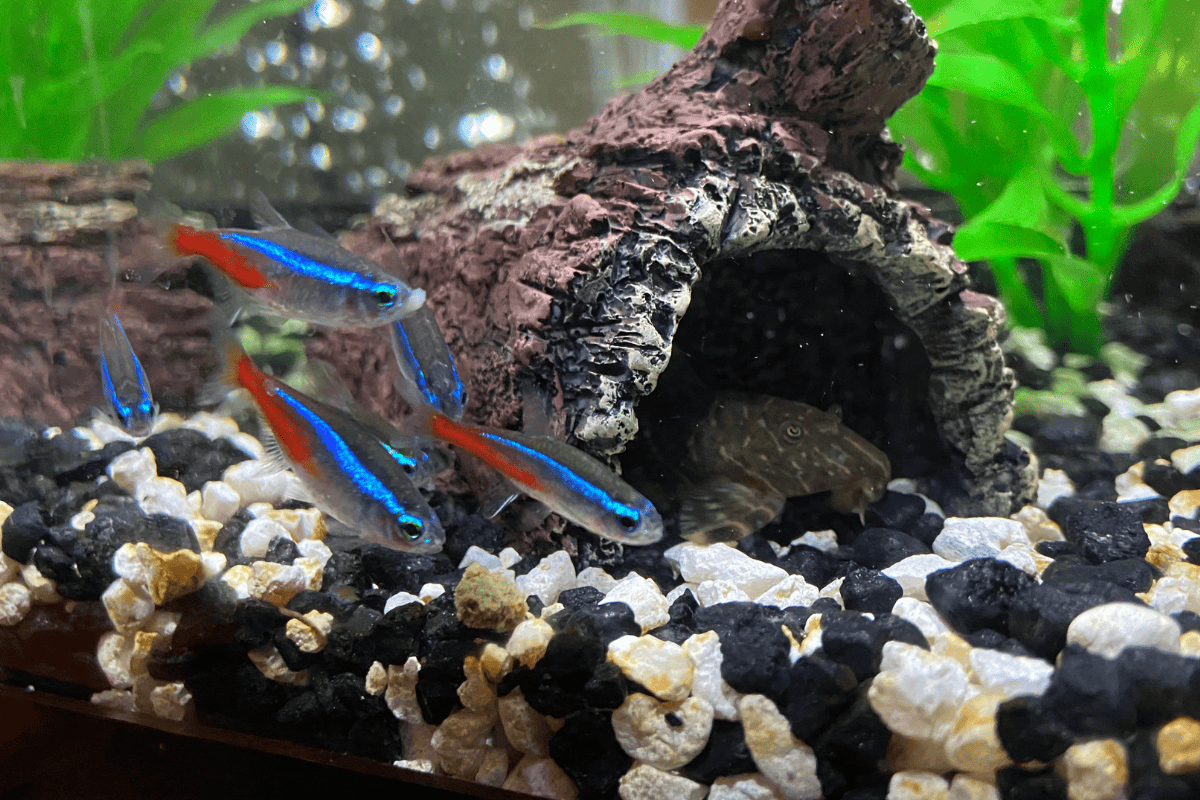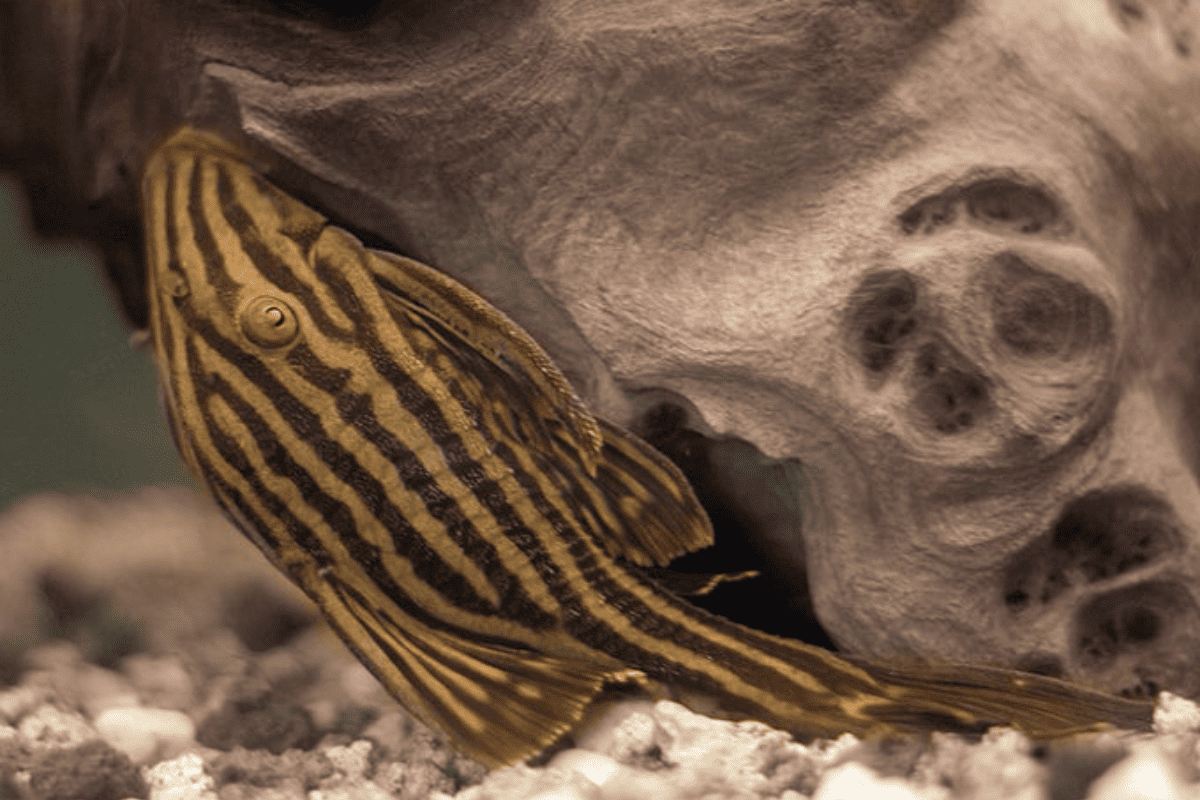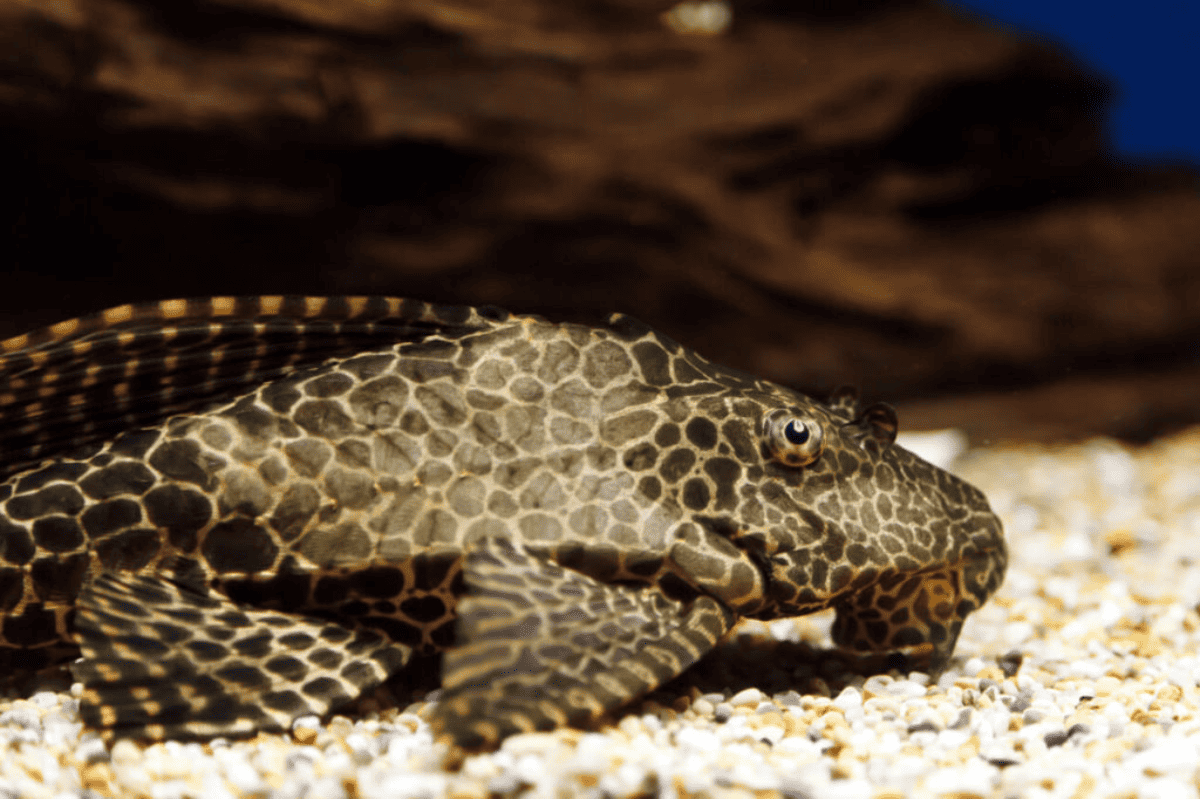Both Plecos and Neon Tetras are popular in home aquariums.
But can they share a tank? What about their water requirements? How will they behave with each other? And what should they eat?
In this article, I’ll cover all these questions and more, so you’ll have all the information you need. Let’s dive in.

Can I Keep Plecos and Neon Tetras Together in the Same Tank?
Yes, you can keep Plecos and Neon Tetras together in the same tank. Their compatibility primarily hinges on their differing habits and preferences.
- Tank Size Matters: Plecos grow large, often reaching 15 inches, while Neon Tetras remain small. Their size difference ensures minimal competition for space.
- Temperature Compatibility: Plecos and Neon Tetras have similar temperature preferences, usually between 72°F to 78°F, ensuring they coexist comfortably.
- Dietary Differences: While Plecos are herbivores munching on algae, Neon Tetras eat small live or frozen foods. This means they don’t compete for food sources.
- Behavioral Complement: Plecos are calm, bottom-dwellers and Neon Tetras are active mid-level swimmers, ensuring they don’t intrude on each other’s territories.
- Distinct Territories: Plecos primarily stick to the tank’s bottom, using hiding spots, whereas Neon Tetras stay in open waters, minimizing territorial disputes.
Also Read: Pleco Fish Tank Mates
Plecos vs. Neon Tetras: Behavior
The first factor worth considering is the Plecos’ and Neon Tetras’s natural behavior. Here is what you should know:
Pleco Fish: Natural Behavior
Plecos are intriguing fish that exhibit behaviors distinctly different from many other aquarium inhabitants.
Originally from South America, these fish have developed habits suited for their native environments.
- Bottom-Dwellers: Plecos primarily inhabit the bottom of tanks and rivers, using their mouths to cling to surfaces, showcasing their scavenging behavior.
- Nocturnal Nature: Plecos are more active during nighttime, often hiding during the day. This pattern mimics their behavior in wild, murky river environments.
- Algae Eaters: In the wild and in tanks, Plecos are known to consume algae, using their specialized mouths to scrape it off surfaces.
- Solitary Tendencies: While Plecos can coexist with other species, they often prefer solitary or less crowded spaces, emphasizing their loner nature.

Neon Tetras: Natural Behavior
Neon Tetras, with their vibrant colors, have behaviors that reflect their schooling nature and mid-water dwelling habits.
Native to the Amazonian waters, their actions in tanks mimic their natural habitat behaviors.
- Schooling Fish: Neon Tetras prefer swimming in groups, and it’s common to see them in schools of 6 or more, displaying their social nature.
- Mid-Water Swimmers: Unlike Plecos, Neon Tetras usually inhabit the mid-level of tanks, darting around and showcasing their agility.
- Omnivorous Diet: Neon Tetras eat a mix of plants and tiny creatures like brine shrimp and daphnia, mirroring their varied wild diet.
- Peaceful Nature: Neon Tetras are typically calm and steer clear of fights, making them perfect for community tanks alongside other peaceful fish.

Ideal Parameters for Plecos and Neon Tetras
Before setting up your aquarium, it’s essential to understand the ideal water conditions for both Plecos and Neon Tetras. The following table highlights these conditions:
| Parameter | Plecos | Neon Tetras | Both Types |
| Temperature | 74°F to 80°F (23°C to 27°C) | 70°F to 81°F (21°C to 27°C) | 74°F to 80°F (23°C to 27°C) |
| pH Level | 6.5 to 7.5 | 6.0 to 7.5 | 6.5 to 7.5 |
| Water Hardness | 6 to 10 dGH | 1 to 10 dGH | 6 to 10 dGH |
Pleco Fish: Ideal Parameters
For Plecos to flourish and display their instinctive actions, they require water conditions similar to their natural surroundings.
These conditions promote their well-being and extended lifespan in domestic aquariums.
- Temperature: Plecos are comfortable in temperatures from 72°F to 86°F, mirroring the warm South American waters they come from.
- pH Level: Plecos thrive in a mildly acidic to neutral pH, usually between 6.5 to 7.5, which helps their metabolic functions operate optimally.
- Water Hardness: Plecos thrive in soft to moderately hard water, usually within a range of 4 to 15 dGH, mimicking their native river environments.

Neon Tetras: Ideal Parameters
Neon Tetras, with their bright colors and active behaviors, require water conditions that mirror the Amazonian waters they originate from.
Proper parameters ensure their vibrant colors and overall well-being.
- Temperature: Neon Tetras flourish in a temperature range between 70°F to 81°F, mirroring the tropical freshwater streams of the Amazon.
- pH Level: Acidic to slightly neutral pH levels, ranging from 5.0 to 7.0, are ideal for Neon Tetras, supporting their natural habitat conditions.
- Water Hardness: Soft water is optimal for Neon Tetras, with a hardness level usually between 1 to 2 dGH, reflecting their Amazonian water conditions.

Plecos vs. Neon Tetras: Tank Setup
Creating a harmonious environment for Plecos and Neon Tetras requires special attention to the tank setup. Here’s a comparison of their individual and collective needs:
| Setup Aspect | Plecos | Neon Tetras | Both Types |
| Ammonia | 0 ppm | 0 ppm | 0 ppm |
| Nitrite | 0 ppm | 0 ppm | 0 ppm |
| Nitrate | Below 40 ppm | Below 40 ppm | Below 40 ppm |
| Tank Size | Minimum 30 gallons | 10-20 gallons | Minimum 50 gallons (considering both species) |
| Foliage | Requires hiding spots | Needs open swimming space | Balance of hiding spots and open swimming areas |
| Decorations | Rocks and caves | Plants and driftwood | Mix of rocks, caves, plants, and driftwood |
| Filter | Strong filtration system | Moderate filtration | Strong filtration system |
| Heater | Yes | Yes | Yes |
| Substrate | Sandy or fine gravel | Fine gravel | Fine gravel with some sandy spots |
Pleco Fish: Tank Setup
When setting up a tank for Plecos, it’s essential to replicate the conditions of their native habitats, ensuring their comfort and well-being.
Given their size and specific requirements, Plecos need a carefully curated environment.
- Ammonia Nitrite Nitrate: Plecos require clean water with minimal ammonia, nitrite, and nitrate levels. Regular water changes and efficient filtration ensure optimal water quality.
- Tank Size: Given their potential size of up to 15 inches or more, a tank of at least 55 gallons is recommended for Plecos.
- Foliage: Plecos appreciate real or artificial plants, providing them shelter and replicating their natural habitat’s vegetation.
- Decorations: Rocks, caves, and driftwood are essential, offering Plecos hiding spots and surfaces to graze on.
- Filter: A powerful filtration system is crucial for Plecos to maintain water clarity and handle their waste production.
- Heater: A stable heater that can maintain temperatures between 72°F to 86°F is essential for Plecos’ well-being.
- Substrate: Sand or fine gravel suits Plecos, resembling the riverbeds they originate from.
- Pump: Good water circulation, achieved with a reliable pump, is beneficial, replicating the flow of their natural habitats.
- Lighting: Moderate lighting works well for Plecos, replicating the dappled sunlight of river environments.

Neon Tetras: Tank Setup
Neon Tetras, being vibrant schooling fish, require specific tank setups that resemble their Amazonian roots. Their setup needs reflect their active nature and mid-level dwelling habits.
- Ammonia Nitrite Nitrate: Like Plecos, Neon Tetras need low levels of ammonia, nitrite, and nitrate. Efficient filtration and regular maintenance are vital.
- Tank Size: For a school of Neon Tetras, a minimum tank size of 10 gallons is recommended, providing them ample swimming space.
- Foliage: Dense plantations, both real and artificial, benefit Neon Tetras, offering shelter and mimicking jungle streams.
- Decorations: Smooth rocks and driftwood pieces help recreate an Amazonian environment for these vibrant fish.
- Filter: A gentle yet effective filtration system ensures clean water without creating strong currents, making it ideal for Neon Tetras.
- Heater: A heater capable of maintaining temperatures between 70°F to 81°F is vital for Neon Tetras’ tropical needs.
- Substrate: Dark-colored sand or fine gravel enhances Neon Tetras’ colors and replicates their natural environment.
- Pump: Moderate water circulation is ideal for Neon Tetras, ensuring oxygenation without strong currents.
- Lighting: Soft, diffused lighting, perhaps supplemented with floating plants, is perfect for showcasing Neon Tetras’ brilliance.

The Dietary Requirements of Plecos and Neon Tetras
Feeding is a pivotal aspect of fish care, and different species have unique dietary needs. The table below provides a brief comparison:
| Dietary Aspect | Plecos | Neon Tetras | Both Types |
| Food Types | Algae wafers, veggies, occasional proteins | Flakes, micro pellets, brine shrimp | Varied diet: algae wafers for Plecos & flakes for Neons |
| Quantity | Depending on size: 1-2 wafers per day | Small amounts, avoid overfeeding | Monitor consumption, avoid overfeeding |
| Feeding Schedule | Mostly nocturnal, feed at night | Daytime feeders | Feed Neons during day, Plecos at night |
Pleco Fish: Ideal Dietary Requirements
Plecos, with their unique mouth structure and scavenging habits, have specific dietary needs that replicate their wild feeding behaviors.
Providing them with a balanced diet ensures their health and vibrant appearance.
- Food Types: Plecos primarily feed on algae, but they also appreciate sinking wafers, vegetables like zucchini, and occasionally protein-based foods like bloodworms.
- Quantity: Depending on the size of the Pleco, a couple of wafers or a slice of vegetable every other day usually suffices, but it’s crucial to monitor for overfeeding or leftover food.
- Feeding Schedule: Plecos, being nocturnal, prefer being fed in the evening or night when they’re most active, ensuring optimal digestion and reduced stress.

Neon Tetras: Ideal Dietary Requirements
Neon Tetras, with their small stature and bright colors, require a balanced and varied diet to maintain their vibrancy and energy.
Meeting their dietary needs guarantees their longevity and overall health.
- Food Types: Neon Tetras thrive on a mix of high-quality flake food, small live or frozen foods like brine shrimp or daphnia, and occasionally plant-based items.
- Quantity: A pinch of food, enough for them to consume within 3 minutes, is typically sufficient, ensuring they’re well-fed without polluting the tank.
- Feeding Schedule: Neon Tetras benefit from being fed 1-2 times daily, usually in the morning and evening, mimicking their natural feeding patterns.

Best Pleco Species to Pair with Neon Tetras
Neon Tetras can’t just be paired with any Pleco species. The size, behavior, and habitat preferences of the Pleco play a big role.
- Bristlenose Plecos: Generally reaching 4-6 inches, they’re a great match for tanks with Neon Tetras.
- Clown Plecos: At a size of 3-4 inches when fully grown and a calm nature, they live peacefully with Neons.
- Rubber Lip Plecos: This smaller breed, growing up to 4-5 inches, is known for its gentle nature, making it ideal for community aquariums.
- Dwarf Plecos: True to their name, their small size ensures they coexist well with Neon Tetras without taking up too much space.
- Zebra Plecos: Capping at about 3-4 inches and with a calm disposition, they’re a good fit with Neon Tetras.
Also Read: Can Plecos And Bettas Live Together?

Pleco Species to Avoid with Neon Tetras
While a good number of Pleco species get along well with Neon Tetras, some can be problematic due to their size or behavior.
- Common Plecos: These can grow massive, up to 24 inches, and might become territorial. Their size and nature can potentially stress or even harm smaller tankmates like Neons.
- Sailfin Plecos: Another large species, they can reach lengths of 18 inches or more, which can overwhelm a tank intended for Neon Tetras.
- Royal Plecos: Averaging around 17 inches when fully grown, their size and potential to be territorial make them less suitable for Neon Tetra tanks.
- Gibbiceps Plecos: Growing to around 20 inches, their size can pose challenges for maintaining a balanced community tank with Neons.
- Vampire Plecos: Although they reach about 10 inches, their more assertive nature might make them less ideal for a harmonious environment with Neon Tetras.
The Right Way to Add Your Pleco to a Neon Tetras Tank
When introducing a Pleco to a Neon Tetra tank, it’s important to make the move smooth for everyone involved. Here’s how to integrate a Pleco without a hitch:
- Quarantine First: Start by keeping the Pleco in a different tank for 2-4 weeks to screen for any illnesses or parasites.
- Temperature Match: Set the Pleco’s bag in the main tank for half an hour to make sure the water temperatures match, minimizing shock.
- Mixing Water Gradually: Over an hour, add about 50ml of the tank’s water to the Pleco’s bag every 10 minutes to equalize water conditions.
- Using a Net with Care: Carefully lift the Pleco out with a net, avoiding the bag’s water, and then put it into the main tank.
- Keeping an Eye on Interactions: For the first two days, watch closely for any signs of tension or stress and adjust the tank setup if needed.

Tips for Harmonious Living with Plecos and Neon Tetras
To keep Plecos and Neon Tetras living peacefully together, ongoing care is key. Here are some pointers for a stress-free tank:
- Offer Hiding Spots: Add some caves or overhangs to the tank to recreate their natural surroundings, lowering stress for Plecos. I personally love the Jabukosu Aquarium Cave (link to Amazon).
- Separate Feeding Times: Give Plecos their food wafers at night when they’re most active and feed Neon Tetras during daytime hours.
- Regular Water Testing: Keep tabs on ammonia, nitrite, and nitrate levels weekly to maintain a safe habitat for both fish species.
- Adequate Tank Size: Choose at least a 30-gallon tank to prevent turf wars and give everyone room to swim.
- Choose Compatible Tankmates: Make sure any other fish in the tank are community-minded and won’t harass your Plecos or Neon Tetras.
- Keep an Eye on Health: Frequently look for signs of illness or stress like unusual swimming patterns or color changes.
- Perform Routine Maintenance: Clean your tank every 2-4 weeks and change out 10-20% of the water each week to keep things balanced.
Best Tank Mates for Plecos and Neon Tetras
When setting up a community tank for Plecos and Neon Tetras, carefully pick other fish that’ll help keep the peace. Here are some great candidates:
- Corydoras Catfish: These bottom-feeders are chill and get along great with Plecos, as they don’t fight over space.
- Guppies: Bright and lively swimmers that hang out near the top of the tank, they blend well with Neon Tetras and don’t clash with Plecos.
- Harlequin Rasboras: Their relaxed nature and preference for mid-tank areas prevent crowding near the bottom where Plecos usually hang out.
- Rummy Nose Tetras: Another calm tetra species that schools nicely with Neon Tetras while steering clear of Pleco zones.
- Dwarf Gouramis: These colorful, top-dwelling fish get along well with both Plecos and Neon Tetras, without getting territorial.
Also Read: Can Plecos And Mollies Live Together?

Conclusions
To sum it up, here are the key points:
- Plecos and Neon Tetras generally get along due to their different sizes, behaviors, and what they like to eat.
- The tank’s size, water temperature, and distinct areas play big roles in their compatibility.
- Knowing the water conditions that each species prefers is vital for their health and happiness.
- A well-designed tank, complete with decor, plants, and a good filter, creates a cozy home for both Plecos and Neon Tetras.
- When pairing Plecos with Neon Tetras, it’s crucial to pick the right Pleco species, as some are more apt for cohabitation than others.

